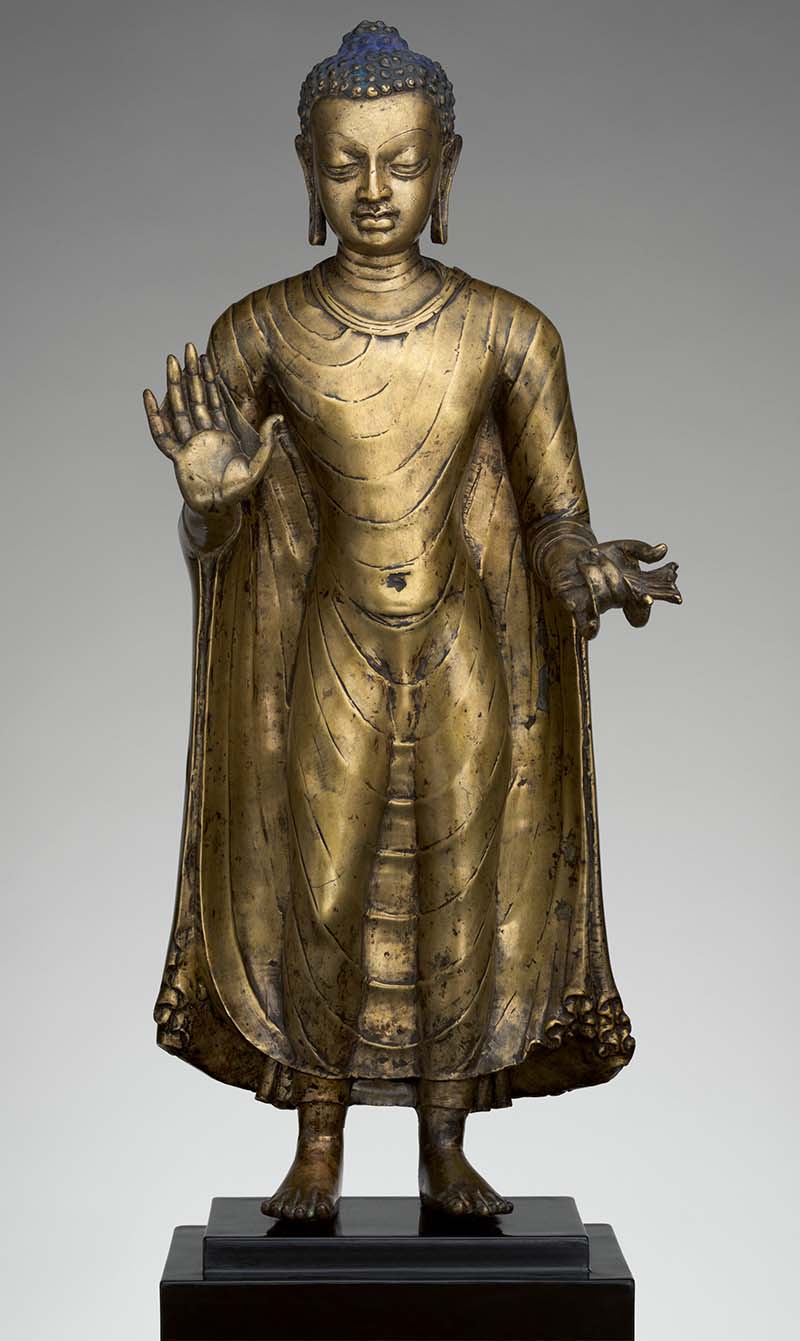A set of hand gestures and finger positions that serve as representational and symbolic devices in Buddhist art and practice, developing around the third century CE, mudras, mean “seals” or “signs” in Sanskrit. These gestures have been adapted in various spiritual and religious systems — such as in Hatha yoga, in Tantric panchamakara observances and as ear-ornaments for the Hindu Kanphata cult, for different interpretative purposes. In Buddhist visual culture, they serve primarily as a mode of expression of implicit or abstract concepts to the lay follower or practitioner, and also illustrate the key principles that were invoked during specific events from the Buddha’s life. After having come into systematic use following their integration into the Buddhist canon, mudras began to assume a variety of stylised forms as the religion itself spread across south and southeast Asia.
The origin of the use of mudras as expressive devices is neither datable nor ascribable. They are believed to signify the subtle manifestations of the Buddha’s states of realisation. The fingers of the hand are thought to represent the five factors that constitute the physical phenomena (elements), experiences, types of awareness and levels of consciousness entailed in attaining buddhahood, so that the various gestural configurations helped realise a synthesis of these factors. Likewise, the positioning of the hands is also imbued with symbolic qualities — the right hand representing the male principle of agency, or samsara, and the left representing the female principle of wisdom, or nirvana. The constant changing of gestures and hand movements during liturgical practices therefore allowed for a range of mental states to be achieved and meanings to be conveyed. The depiction of mudras in sculptural art came into prominence around the fourth and fifth centuries CE with their increasing appearance, such as in the Ajanta and Ellora caves, temples and monastic complexes, and their articulation in the texts of Mahayana Buddhism.
Of the large number of gestures that had subsequently evolved, the five most common hand gestures depicted became the focal mudras of Buddhism: they are the dharmachakra mudra, the bhumisparsha mudra, the varada mudra, the dhyana mudra, and the abhaya mudra. Also common in Buddhist iconography are the vitarka mudra, the bodhyagri mudra, vajrapradama mudra and the anjali mudra — all variations or derivations of the five main mudras.







![The façade of the Maneckji Seth Agiary, a Zoroastrian fire temple, is a standout example of the popularity of the Persian Revival Style in Western India in the 19th and 20th centuries. This style was often seen in the architectural patronage of the Parsis, who emerged as one of the most influential mercantile communities of British India. Popular motifs of this style, like the mythical lamasus (winged bulls with human heads) and the faravahar (a winged guardian spirit in Zoroastrianism), drew on the historical art and architecture of the Achaemenid and Sasanian empires from sites like Persepolis, Bisotun, Taq-e Bostan, Naqsh-e Rostam and Naqsh-e Rajab in Persia.
The Parsi community’s adoption of this style occurred largely due to their networks of global commerce and politics, allowing them to access and translate research of ancient Persia into visible symbols that underlined their association with antiquity, imperial power, and art.
نمای آتشکدهی زرتشتی مانِکجی سِت نمونهی بارزی از رواج سبک «احیای [معماری] ایرانی» در غرب هند طی سدههای نوزدهم و بیستم است. این سبک غالباً در بناهایی دیده میشد که پارسیان، از بانفوذترین جوامع بازرگان در هند بریتانیا، بانیشان بودند. نقشمایههای محبوب این سبک، مانند گاو بالدار اساطیری (لاماسو) و فَروَهَر (روح بالدار نگهبان در دین زرتشت)، برگرفته از هنر و معماری شاهنشاهی هخامنشی و ساسانی، در جاهایی چون تخت جمشید و بیستون و طاق بستان و نقش رستم و نقش رجب، بود.
اقتباس جامعهی پارسیان از این سبک بسیار مرهون روابط گستردهی تجاری و سیاسی آنها بود که دسترس به پژوهشها دربارهی ایران باستان و برگردانیدن آنها به نمادهای بصری را ممکن میکرد و بر پیوند پارسیان با دوران باستان و قدرت شاهنشاهی و هنر تأکید میکرد.](https://mapacademy.io/wp-content/plugins/instagram-feed/img/placeholder.png)
